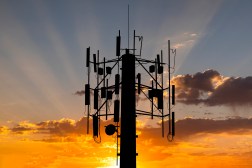Pentagon’s second wave of 5G RFPs weeks away

The Department of Defense plans to issue additional requests for proposals (RFPs) in the coming weeks for 5G wireless prototypes at a second tranche of U.S. military bases.
DOD announced 5G experiments at four initial bases in 2019 — Hill Air Force Base in Utah, Joint Base Lewis-McChord in Washington, Naval Base San Diego, and Marine Corps Logistics Base Albany, Georgia — exploring dynamic spectrum sharing, augmented reality (AR) and virtual reality combat training, and smart warehouses.
The second tranche announced in June includes seven more bases and will expand the Pentagon’s three-part prototyping and experiment effort to accelerate the use of 5G, operate everywhere the military deploys, and innovate in preparation for future wireless generations.
“DOD recognized that industry is driving 5G technology with massive investments,” Joe Evans, technical director for 5G at DOD, said during an ACT-IAC webinar Thursday. “The projection on capital expenditure in the U.S. through 2025 is about $350 billion.”
Samsung alone spent $16.7 billion on 5G research and development in 2018, an amount no Pentagon network and communications program has ever reached, Evans added.
New RFPs will be issued through the National Spectrum Consortium and Information Warfare Research Program.
One prototype will test shipwide and pierside connectivity at Naval Station Norfolk in Virginia with private sector implications for both the cruise and freight industries.
Another prototype seeks to quickly move massive amounts of data from aircraft to mission support for predictive maintenance at Joint Base Pearl Harbor-Hickam in Hawaii, a capability that could also benefit the airline industry.
DOD will experiment with AR support for medical training and telemedicine at Joint Base San Antonio, allowing personnel to contact specialists at hospitals to assist with front-line treatment. Such work is already benefiting coronavirus pandemic response because 5G allows for better video and low-latency interactions, Evans said.
A more Pentagon-oriented effort is occurring around wireless connectivity for tactical operations centers at the Fort Irwin National Training Center in California, Fort Hood in Texas and Marine Corps Base Camp Pendleton in California.
“Really the idea there is to get rid of all the red and green wires you find in combat operations centers and replace those with wireless technology to improve mobility and make targeting our forces harder,” Evans said.
The prototype could help NASCAR, which has to quickly stand up and tear down operations centers as it moves track-to-track on a weekly basis.
A final prototype at Tinker Air Force Base in Oklahoma deals with bidirectional spectrum between commercial and DOD communications systems, more dynamic spectrum sharing than earlier technologies like the Citizens Broadband Radio Service, Evans said.
Joint Base San Antonio and other remote sites have formed a 5G core security experimentation network for evaluating the security and interoperability of 5G backbone networks. The tests could help additional U.S. companies enter the 5G market, Evans said.






